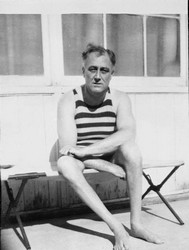FDR With Polio
|
| updated |
Copy Link Code
|
 Poliomyelitis, commonly called polio, struck Franklin Delano Roosevelt at the age of thirty-nine, a rather old age considering that the infectious disease usually attacked younger people. He was on vacation at Campobello Island in Canada, the family's summer home. At first, doctors thought he had a form of the flu; as his legs weakened, he was diagnosed with a spinal lesion. Finally, Dr. Robert Lovett, an American polio specialist, confirmed that Roosevelt had the crippling disease.
Poliomyelitis, commonly called polio, struck Franklin Delano Roosevelt at the age of thirty-nine, a rather old age considering that the infectious disease usually attacked younger people. He was on vacation at Campobello Island in Canada, the family's summer home. At first, doctors thought he had a form of the flu; as his legs weakened, he was diagnosed with a spinal lesion. Finally, Dr. Robert Lovett, an American polio specialist, confirmed that Roosevelt had the crippling disease.
Franklin D. Roosevelt and polio were complex companions. Generally leaving those it attacked in a dependent state, polio did not find it so easy to stop Roosevelt - he fought back. Although polio paralyzed Roosevelt from the waist down, he had his legs and hips fitted with iron braces, and he taught himself to walk short distances by twisting his body in one direction while he balanced himself with a cane. Roosevelt also combated the effects of polio by using a wide range of different therapies, finally deciding that hydrotherapy, a warm water treatment, was the best for him. In 1926, Roosevelt bought property in Warm Springs, Georgia that included a natural spring where the water temperature was usually around eighty degrees and contained an influx of healing minerals, both of which were recommended to soothe the pain of polio.
Franklin Roosevelt didn't hide the fact that he had polio, but he downplayed the acuteness of his infirmity. FDR wanted a life in politics, which required good health and stamina, so he rarely referenced his disability and neither did others. The public seldom witnessed him sitting in a wheelchair or wearing the leg braces that helped him walk. Without ever being asked to do so, the press very rarely took a picture of Roosevelt while in motion.
Despite the fact that Roosevelt never made an issue of his polio, he worked diligently to help others crippled by the disease. FDR used his influential position as a wealthy politician and president to:
- Establish the Roosevelt Institute for Rehabilitation, a hydrotherapy facility he built on his Georgia property, which is still in operation.
- Form physical therapy sessions in Warm Springs, which he often led, for patients recovering from all types of paralytic disorders. His "patients" called him "Uncle Rosey."
- Promote the design and manufacture of orthopedic supports at his Warm Springs facility to help paralyzed people function more normally and lead productive, independent lives. The hand controls on FDR's personal car were developed there.
- Establish the National Foundation for Infantile Paralysis to provide supportive care for polio victims and to conduct research regarding paralyzing diseases.
- Co-found the March of Dimes with the comedian Eddie Cantor as a way to raise funds for research. To collect money, people were asked to mail a dime to the president. In recognition of his contribution towards eliminating polio, Congress put FDR's face on the dime, which was released on January 30, 1946, the president's birthday and the first day of the annual March of Dimes campaign.
By the time the Salk vaccine was discovered as a preventive measure against polio in 1955, President Franklin Roosevelt's buoyant spirit and relentless determination were encouraging to those that believed polio could and would be conquered; he also became of symbol of faith and perseverance to all handicapped people, the group that FDR never left out or forgot.
